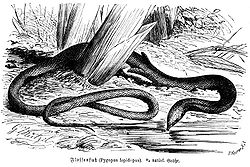Flap-footed lizard
| Pygopodidae | |
|---|---|
 |
|
|
Pygopus lepidopodus,
from Brehms Tierleben, 1892. |
|
| Scientific classification | |
| Kingdom: | Animalia |
| Phylum: | Chordata |
| Class: | Reptilia |
| Order: | Squamata |
| Infraorder: | Gekkota |
| Family: |
Pygopodidae Boulenger, 1884 |
| Subfamilies | |
|
2, See text |
|
 |
|
| Geographic range of the family Pygopodidae in Australia and New Guinea. | |
from Brehms Tierleben, 1892.
2, See text
Pygopodidae (commonly known as legless lizards, snake-lizards, or flap-footed lizards) is a family of squamates with reduced or absent limbs, and are a type of gecko. There are at least 35 species in two subfamilies and eight genera. They have unusually long, slender bodies, giving them a strong resemblance to snakes. Like snakes and most geckos, they have no eyelids, but unlike snakes, they have external ear holes and flat, unforked tongues. They are native to Australia and New Guinea.
Pygopodids have no fore limbs at all, but they do possess vestigial hind limbs in the form of small, flattened flaps. These may have some role in courtship and defensive behaviour, and may even aid in locomotion through vegetation. Some species are insectivorous burrowing animals, but others are adapted to moving through dense spinifex or other vegetation. Like the geckos, pygopodids lay two eggs in each clutch and nest communally. Some nests have been found to have as many as 30 eggs. Also like other geckos, pygopodids have the ability to vocalise - emitting a high-pitched squeak. Snakes are incapable of vocalising.
Pygopodids can hear tones higher than any other reptiles. Individuals in the species Delma pax can respond to a 60-decibel sound with a frequency of 11,100 Hz, more than an octave above the highest note on a standard piano.
FAMILY PYGOPODIDAE
...
Wikipedia
